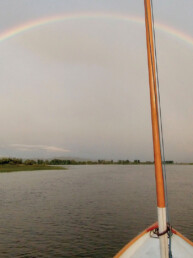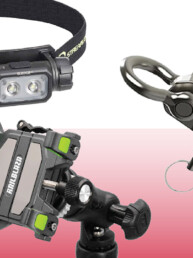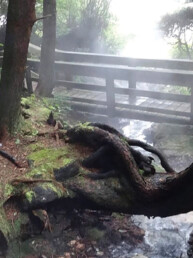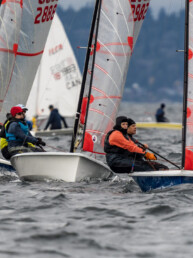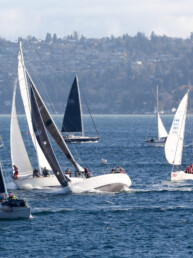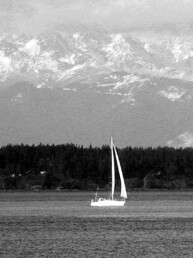This article was originally published in the November 2021 issue of 48° North
Sitting in our cockpit off Jones Island at sundown, I looked to the northeast and watched as shifting tones of pink, peach, and slate enveloped British Columbia’s North Shore Mountains — the same mountains my parents can see from their home east of Vancouver.
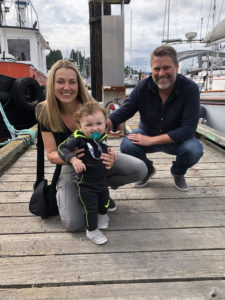 The realization was bittersweet. It was late July 2020 and the coronavirus pandemic had scuttled our plans to cruise in the Gulf Islands for a few weeks. British Columbia, where I was born and raised, was so close but had never felt so far away. The invisible maritime border, which we had easily crossed many times into Canada, seemed as impenetrable as an iceberg.
The realization was bittersweet. It was late July 2020 and the coronavirus pandemic had scuttled our plans to cruise in the Gulf Islands for a few weeks. British Columbia, where I was born and raised, was so close but had never felt so far away. The invisible maritime border, which we had easily crossed many times into Canada, seemed as impenetrable as an iceberg.
There would be no meeting up with my parents on Salt Spring Island, no taking the boat to Vancouver to see friends that summer. I suddenly felt profoundly homesick. I wanted nothing more at that moment than to take our floating home back to the place in the world that felt most familiar and comforting to me.
Thirteen months later, we headed out from Point Hudson Marina in Port Townsend in the middle of the night to catch the currents across the Strait of Juan de Fuca. It was 3:30 a.m. but we were both wide awake — amped not only by the novelty of crossing the strait at night and the prospect of seeing the sun rise over it, but with excitement and a little trepidation about our destination.
We were heading for Sidney with plans to spend two weeks cruising in British Columbia. We thought we’d met all of the Canadian government’s entry requirements, but it was only a few days after the border had reopened to vaccinated travelers and we weren’t sure how it would all pan out. We needn’t have worried, it turned out — after a few questions from a customs agent on the other end of the line at the Port Sidney Marina customs dock, we were in.
Exhausted from the day’s early start but too happy to sleep, we tied up at the marina and headed out to explore Sidney and stop at a pub for some vacation planning. Over a round of Caesars (the Canadian version of a Bloody Mary) we discussed options for exploring beautiful British Columbia. We settled on a mix of revisiting a few favorite spots, seeing a new place or two, and trying to connect with several of my relatives.
The next morning, we pointed the boat of our Passport 40, Rounder, for Portland Island — just south of Salt Spring — stern-tied in Royal Cove on the island’s north end and headed ashore. Portland has miles of hiking trails, a beautiful shell midden beach and an interesting history. Once the site of a First Nations village, Portland was later occupied by Hawaiian immigrants who settled on the island in the 1880s and farmed there — visitors can still pick several varieties of heritage apples in the old Palau Orchard, named after Hawaiian settler John Palau.
We could have happily lingered longer in tranquil Royal Cove, but I learned that my cousin Darren and his family, who we hadn’t seen since before the pandemic, were cruising in the islands on their catamaran. We headed over to the village of Ganges on Salt Spring Island to meet them and spent a memorable day visiting a nearby cidery, where we sat at a table overlooking apple and pear orchards, checking out each other’s boats — their Lagoon 44 and our Passport 40 are about as different as two vessels can be — catching up on family news and talking boats until late in the evening.
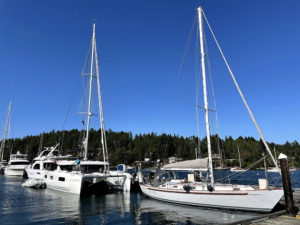 We headed off the following day with slightly fuzzy heads and plans to meet up at Butchart Gardens. I hadn’t been there since going with my family as a child and had long intended to go back, and Darren had never been.
We headed off the following day with slightly fuzzy heads and plans to meet up at Butchart Gardens. I hadn’t been there since going with my family as a child and had long intended to go back, and Darren had never been.
Marty and I hoped to find space in Tod Inlet, a sheltered cove south of Brentwood Bay close to the gardens, but we arrived to find the anchorage packed with boats. Disappointed, we headed back up the inlet to a small cove where Butchart Islands has a dinghy dock near its entrance, plus five mooring balls that boaters visiting the gardens can stay on one night for free.
Our disappointment soon abated. We had the beautiful anchorage to ourselves and enjoyed a peaceful, warm evening in the cockpit. The next day we spent a couple of hours walking around the gardens, which are immaculate and impressive, if a little spendy (admission is $31 for adults), though the complementary moorage mitigates the cost.
From there we headed to Cowichan Bay, a seaside village on the east coast of southern Vancouver Island. We’d heard the town was worth visiting, but it was charming in a way we hadn’t expected. A combination of working waterfront and a cluster of businesses along a narrow street lined with marinas, Cowichan Bay felt like a throwback, the sort of place that epitomized Pacific Northwest boating 50 years ago. With its hand-painted signs and funky vibe, it seemed unpretentious and authentic, largely untouched by gentrification.
We got a slip at the Cowichan Bay Fishermen’s Wharf Association, a rustic marina dating back to the 1860s that was occupied by a mix of commercial and recreational boats. The town, located directly up the dock from the marina, has restaurants and shops, a small maritime museum, chandlery, an excellent bakery, and a pub with spectacular views of the bay and nearby Mount Tzouhalem.
As much as we liked the town, the real highlight, and the main reason we went, was a visit from another cousin, his wife and their 14-month-old baby, Zephy, who live in nearby Duncan. I hadn’t seen them since before the pandemic and longed to meet the baby boy I’d watched in photos and videos grow from an infant into a cherubic toddler who’d just started walking — and who was even more impossibly cute in real life. We met at the bakery, chatting and taking photos of Zephy before heading down the dock for a tour of our boat.
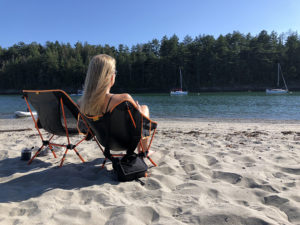 Sated with baby goodness and family time, we headed to Annette Inlet off Prevost Island, one of our favorite spots in the Gulf Islands, and spent a couple of quiet days hiking, reading and playing cribbage before moving on to tiny Cabbage Island, our last stop in B.C.
Sated with baby goodness and family time, we headed to Annette Inlet off Prevost Island, one of our favorite spots in the Gulf Islands, and spent a couple of quiet days hiking, reading and playing cribbage before moving on to tiny Cabbage Island, our last stop in B.C.
I’d been to Cabbage many years ago on an uncle’s sailboat but had forgotten how striking the low-slung island and adjacent Tumbo Island are, with their sweeping views, forested shores and dramatic stone formations. We snagged the last mooring ball in the anchorage, then dinghied ashore to tidepool and enjoy Cabbage’s sandy beach. After setting up our collapsible chairs, we kicked back with a thermos of icy drinks, feet in the sand, and soaked up the scenery. It was late August and the day was glorious, sunny and perfect.
I’ve lived in the U.S. for two decades now, most of that in Seattle, less than three hours from where I grew up. I’m a citizen of both countries, with one foot in each, but B.C. still feels like home. The waters of my home country being off-limits during the pandemic made me feel off-kilter, out of balance. A piece of connective tissue, one that ties my life now back to my roots, was missing. Crossing that water boundary somehow restored it.
Back in the cockpit off Cabbage Island after dinner, we sat and watched a long and especially breathtaking sunset over the B.C. mainland. This time, there was no sadness. I was exactly where I wanted to be.

